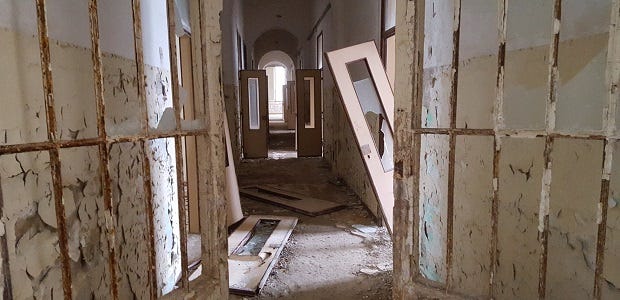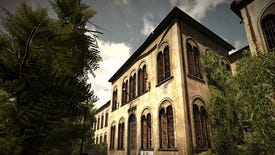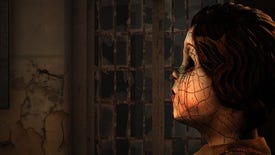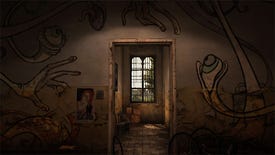True Horror: The Town Of Light's Historical Inspirations
Stepping into the past
Last week, I visited Volterra, an Italian town that is home to the now-derelict Ospedale Psichiatrico di Volterra, a former psychiatric hospital. Upcoming game The Town of Light [official site] is set in that hospital and its grounds, and I had a chance to explore both the virtual recreation and the actual buildings. I also spoke to the team behind the game and Giampaolo di Piazza, a psychiatrist and Vicepresident of the Italian Society of Phenomenological Psycopatology about the history that informs the game.
This is the story of a game that brushes the tropes of the horror genre aside, and finds its sorrow and terrors in the history of a place and a way of thinking.
All blockquotes are taken from an interview with Giampaolo di Piazza, conducted with the help of a translator. All photographs are my own.
Town of Light is a harrowing experience. Developers LKA, led by Luca Dalco whose background is in theatre, are insistent that this is not a horror game. And it isn't. Not in the conventional sense. There are no chase sequences, there's no clumsy combat and there isn't a single supernatural entity in sight.
There are bumps in the night though. And bumps in the day, for that matter. There is cruelty and abuse and imprisonment and fear. Town of Light might not be a horror game but it is absolutely horrifying and the fact that it's based in the history of a real place, and the wider social history of mental health treatment, makes its terrors and grotesques all the more affecting.
Walking through the corridors and rooms of one of the buildings that made up the patient's quarters in the real Volterra Asylum, there was no sense of spookiness or dread. The architecture is beautiful and from the outside, it'd be easy to mistake the building for an extravagant palazzo, though its relative isolation speaks of a building not wishing to impress itself upon the neighbours.
It's not isolated in the sense that you might expect. Volterra itself is relatively aloof, perched atop hills that, on the day I visited, were draped in mist. The only sign that life existed beyond that mist came when the church bells rang to summon the devout and the dutiful – somewhere, beyond the veil, another set of bells rang out as if in response. Towns like ships at sea, passing so close but never confirmed as visual entities. It's enough to make you believe in ghosts and the asylum itself is something of a Mary Celeste. It's separation from the town is slight but it is a distinct entity, an enormous expanse that runs away from the inhabited areas.
I only saw the interior of a single building – the game allows you to explore at least two and a portion of the grounds as well – but the institution was a self-sustaining settlement.
“The patients grew their own crops and raised their own livestock. There were barns, fields, storehouses. An abattoir. They would have made their own clothes and even learned carpentry so they could carry out repairs. This was partly to provide occupational distractions and therapy, but it may also have been a financial consideration.”
In the portion of the game I played – a two hour session that covered perhaps half of the story – there is no sense of the asylum as a functional place. Renee is exploring a derelict building and remembering the past and her memories of that building focus on the savagery of treatment, the lies of the system and the fear of being abandoned.
The key to the entire story, I think, comes in an early line: “When you are mad, you are invisible.” Town of Light isn't simply about the specifics of institutional abuse within this one place at this one time, it's about the vanishing of the sick and those who cause discomfort. That discomfort could take many forms.
“At that time, questioning fascism could lead to commitment in a place like Volterra. They would call it something like political mania.”
While some people were deliberately targeted, others were simply behaving in the wrong way at the wrong time.
“Being publicly drunk might be seen as causing danger to the self or others, and someone who acted strangely in public might be seen as hysterical. 'Abnormal' sexual urges might be seen as a result of mental abnormality. Women who had any sexual urges at all were sometimes considered to be unnatural.”
This is reflected in the game, which contains scenes of sexual assault perpetrated by staff and visitors, alongside admonishments and punishments for patients who express or act upon sexual thoughts and desires. If the sheer horror of the acts, depicted in the 2d artstyle of the cutscenes, weren't terrible enough, the injustice of the situation and the impossibility of escape or redress is the stuff of nightmare.
In retrospect, Renee's treatment pisses me off almost as much as it upsets me, so the game deserves credit for pushing away that anger. Renee doesn't have the strength to be angry. It seems likely that she's been convinced that she doesn't even have the right to be angry. There's also the fact that she disassociates from the memory of her situation, which leads into the central mechanic of the game.
You're rediscovering the past, walking through the ruins of a system that you once imprisoned you. There are similarities to Gone Home, both in the sense of retracing steps through a place that is known but has become mysterious, and in the actual structure of the game. Puzzles are rarely more complex than following leads and discovering new clues as you piece together your life within the asylum, but where Gone Home took place within a curated space that was clearly the work of artful level designers rather than real world architects, Town of Light's setting is a 1:1 recreation of the actual institution.
I played the game before visiting the asylum and stepping inside was uncanny. The way that the paint has rippled away from the walls into a strange topography (like a frozen and curdled milk sea, sez my crappy inner poet) is captured perfectly by the in-game textures. But it's the layout that's most striking. The scale, in-game, is precise. Corridors don't stretch into darkness to conjure an atmosphere, they do so because that's how they were built.
The lack of concessions to game flow in the architecture caused some problems during my playthrough. As you move through the building, Renee's inner monologue guides you toward specific places as you follow her thought processes and retrace her journey through the institution. Occasionally, I'd identify the room I needed to find – a mailroom perhaps or a specific treatment area – and even after consulting the map on the wall near the elevator, I wasn't sure where to go. That's because the layout of real places, be they office or institution, is not always logical.
That's not necessarily a bad thing. Given the lack of overt puzzling, exploring the area is the key challenge. But Town of Light works best as a sort of interactive historical document rather than a challenge. To that end, there are plenty of papers to read and illustrations to examine, all as authentically recreated as possible.
But Renee herself is not real. She's a composite character, with a backstory created by Luca but drawn from research around actual inmates. There's a risk, then, that her story becomes a compilation of every extreme, a catalogue of the worst case scenarios. She certainly seems to be a canvas on which suffering has been drawn, in all of its shades, and as the punishing treatments and awful situations piled up, I felt she might have been TOO much of a composite.
“Often there was no diagnosis as we would understand it. Patients might show what we recognise as being schizophrenic tendencies but they might also be epileptic or depressed and end up on the same ward as one another. That's because the diagnosis could change from day to day – and so could treatment. People were treated and labelled based on their moods and it's possible that the treatment they received the day before might cause the mood that required treatment the next day.”
In that light, Renee's shipment from ward to ward and from horror to horror seems less like a ghost train of terrible vignettes and more like a condensed trip through a possible past.
“Many – if not most – of those committed would have spent decades in the asylum. They had no freedoms and no real rights, and it was sometimes the case that their families were glad to have them removed. If nobody was willing to take responsibility for a patient who was due to be released, they wold remain in the asylum indefinitely. There was no social reintegration and when it came to patients who were manic or over-active, treatment would often involve little more than sedating them for long periods of time.”
True to their mission statement, the team behind Town of Light have created a game that explores the social history of these institutions without making the monstrosities manifest in the form of shadow creatures or deranged doctors and inmates. The truth, or this version of it, is horror enough.
The game isn't simply a parade of misery though. There is, as the title suggests, light in the darkness. Renee is afraid of the light, however – it exposes and probes. Bright lights are the things that shine in your face from the ceiling as you lie, limbs spread, waiting to be examined, or strapped in a seat ready to be shocked. They are at the end of the doctor's hand as he inspects your face, his own hidden by the glare.
In the game's most obvious dismissal of the tropes and dangerous stereotypes that frustrate me so much whenever I encounter asylums in horror, one sequence has you seeking the darkest place possible. Windows can be shuttered, doors can be closed, power can be cut – all in pursuit of peace. As the light fades, the ward seems still and calm, and the fear of the dark that is central to so many games is turned back on itself.
I hope for more of that in the second half of the game. Whether the gesture toward the fourth wall is intentional or not, it's a creative flourish that stands out in a game that for all the beauty of its recreation, is perhaps a little too beholden to reality. It feels like a documentary at times, which is preferable to an outlandish piece of gore-laden fiction, but I think there may be too much restraint.
My suspicion is that there are inventive sequences to come, however, as Renee moves beyond that initial building. And my complaints are quibbles – I'm hugely impressed by the game's honesty, which is sometimes brutal, but never felt exploitative or gratuitous. Given some of the violence shown (both clinical and otherwise), I thought the game might be too blunt in its portrayal of the worst parts of Renee's life, obscuring the social history and character with shocking scenes but the quieter moments are still devastating.
Leafing through a pile of letters unsent and unread hit me harder than any of the more morbid or terrifying cutscenes.
There's an optimism in the game as well, which might seem a strange thing to write. The asylum itself is in the process of being reclaimed, by nature as roots and branches snake through windows, and by art. Along with the spraypainted images that have repopulated its wards and corridors, there are political messages about the way in which people were treated, not just by that particular institution but by many of the more sinister elements of Italian history and modern society. And, in the treatment of the ill and the unwanted, that history isn't unique to Italy.
Town of Light is part of that process of reclamation. “The mad are invisible”, Renee says, and it's tempting to make the horrors of the past invisible as well. To hide the shame. Better to shine a light there and recognise how we went wrong, all the better to improve ourselves.
The Town of Light is out February 26th.



















